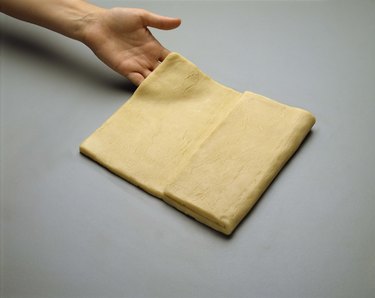
Puff pastry and croissants, when done well, are some of the lightest, flakiest and most delicate pastries in a baker's repertoire. They bake to a high and crisp finish, with a golden brown color and plainly visible layers of delicately flaky dough. They're made using very similar ingredients and techniques, but crescent rolls differ from puff pastry in their use of yeast.
Laminated Doughs
Video of the Day
Americans tend to think of croissants and puff pastry as French, but the French themselves refer to that type of pastry as "Viennoiserie" in deference to the skills of bakers from the Austrian capital. In English they're referred to as laminated doughs, because of how they're made. The baker prepares an elastic dough, then uses it to wrap a flat square of butter or other fat. The dough and its layer of butter are rolled out, folded, then rolled out again several times, creating a dough that contains hundreds of layers.
Video of the Day
Puff Pastry
Puff pastry is a simple dough to make, though the rolling and folding requires a degree of skill. The basic dough itself contains just flour, water, salt and a small amount of butter. When the butter is encased in this dough and rolled and folded according to the classical method, it yields a dough with almost 1,500 layers of pastry and butter. Simplified methods still usually yield 500 or more layers. The layers of butter -- or sometimes margarine or shortening, in commercial puff pastry -- keep the layers of pastry separate as they bake. The water in the pastry, cooking out as steam, causes the layers to lift and separate. Well-made puff pastry will quadruple in height as it bakes.
Croissants
Croissant dough is made using a similar technique, but with some noteworthy differences. First, the layer of butter that's rolled into the dough is smaller relative to the amount of dough. That means croissant dough isn't as rich as puff pastry. It's also rolled and folded fewer times, so it's less flaky and doesn't get as much rise from trapped steam. Instead, the basic dough is leavened with yeast like other breads. The combination of yeast and the folded dough technique results in a crescent roll that's richer and flakier than most breads, but easier to make than puff pastry.
Other Laminated Pastries
Similar pastries are made all across Europe. For Americans the best-known version is probably Danish pastry. In Denmark they're known as "wienerbrod," or Viennese breads, again in tribute to that city's mastery of pastry baking. The doughs are made in much the same way, but vary from croissants by including eggs, higher amounts of butter and sometimes sugar in the dough. Any patient home baker can make these doughs, with no more specialized equipment than a rolling pin and a place in the refrigerator for the dough to rest after it's rolled. Once made, the doughs can be frozen either in sheets or shaped into pastries, then baked directly from the freezer.